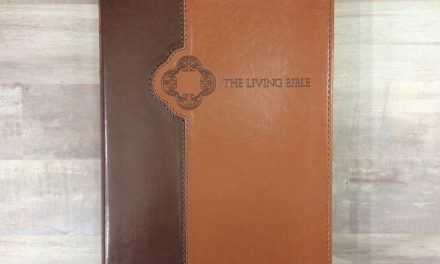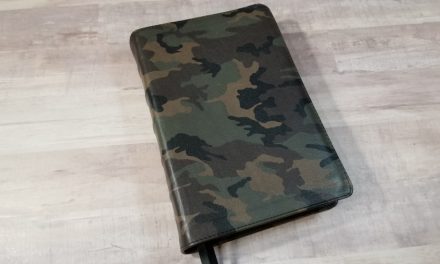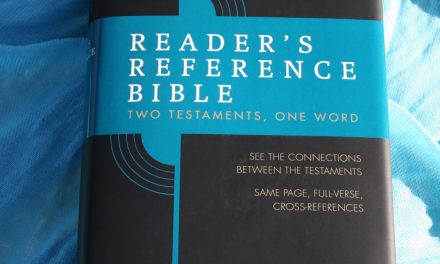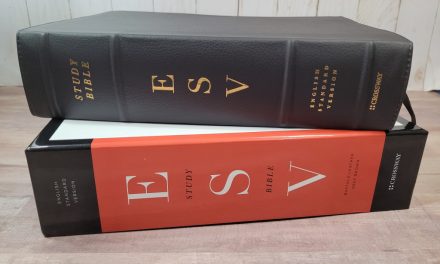Holman’s latest HCSB Bible, the Gospel Project Bible, is a devotional Bible that focuses on Christ as the unifying theme. From Genesis to Revelation it shows Jesus in the center of God’s plan of redemption. The purpose of this Bible is to show the overarching story and help readers see the connections. It includes 140 illustrations by Gustav Dore’.
Binding
This edition is hard cover without a dust jacket (I prefer them without dust jackets because they’re easier to handle). Holman continues their trend of including a ribbon marker with hard cover editions. I wish more publishers would do this. It has a sewn text block. The overall size is 9 3/8 x 7 x 1 ¼.
Paper
The paper’s gsm is probably between 28 and 30. It’s decently opaque. It feels like the same paper used in the Holman study Bibles. It has a white tone and does not have a glare.
Typography
The setting was typeset by 2K/Denmark and as expected it looks outstanding. The text is set in double-column paragraph with poetry in stanzas. OT quotes are in bold print and set apart. Section headings are bold in larger print, so they stand out nicely and make it easy to scan the page.
The font is around 9-point black letter, and is about a medium darkness. It’s very consistent throughout. The font is easy to read.
There are around 46 character per line with columns that are almost 2 ½” wide. The spacing is excellent. The text never feels cramped or awkwardly spaced. It also has a good leading, which gives enough space for underlining and helps improves readability.

Center-column references and reference keys within the text are teal. If there are too many to fit within the center column the rest are placed under the last verse on the page. Footnotes are placed in the footer. The header contains the book names and chapter numbers in the outer corners, and the page number in the center.
Some of the extra material is placed within the text. I like how it looks. It takes one full column and the space of the center column references, so it overlaps and stands apart. The devotional material is on its own pages.
References
The references are in the center column and are keyed to the text with lower-case letters in bold. There are lots of cross references for study. I was impressed with the number of references of the verses I checked and I think this is one of the strengths of this Bible for study. Here are a few examples:
- Genesis 1:1 – a. Ps 90:2; 102:12; Isa 4:21; Jn 1:1-3; Eph 3:21; b. Neh 9:6; Is 40:12-14; 43:7; Jr 10:12-16; Am 4:13; Rm 1:25; 1Co 11:9; Rv 4:11
- Matthew 17:20 – d. Mt 21:21-22; Mk 11:23; Lk 17:6; Jn 11:40; 1Co 13:2; e. Mk 9:23; 13:31
- Mark 11:23 – h. Ps 72:19; Rv 22:21; i. Ac 10:20; j. Jn 3:16; Ac 10:43; Rm 10:9; 1Pt 1:8-10; k. Mk 9:23; Jn 11:22
- John 1:1 – a. Gn 1:1; Col 1:18; b. Jn 1:14; 1Jn 1:1; Rv 19:13; c. Jn 20:28; Php 2:6
- 1 John 1:1 – a. Jn 1:1; 1Jn 2:13-14; b. Ps 119:25; Jn 1:1, 4; 5:24; Php 2:16
Footnotes
The footnotes are placed in the footer and are keyed to the text with upper-case letters. They also include the chapter and verse numbers in bold to make them easier to find. They include alternate renderings, explanations and clarifications, measures, quotes, manuscript variances with the manuscripts identified, etc. I find the notes fascinating and useful for study.
In-Text Devotionals
Within the text are lots of short points and full-page devotions that give information and insights. There are several types and over 200 for each type. They include:
- Devotionals
- Voices From the Church
- Christ Connections
- Missionary Applications
- 99 Essential Doctrines
The devotionals are what make this Bible more than just and great cross reference Bible. It doesn’t feel overly loaded down by them and they can be ignored easily enough. They don’t even make the Bible feel much larger than it probably would be anyway.

The devotions include Voices From the Church, Christ Connections, and Missionary Applications – with all of these appear on the same page. The 99 Essential Doctrines are placed throughout Scripture where they’re needed as call-outs. They don’t feel like they’re in the way or distracting.

The purpose of the devotions are to teach doctrine. Most of the doctrine seems to be non-denominational in nature, or at least mainstream and widely accepted, but there is some bias as is expected. Like always I recommend that you do your own study.

Book Introductions


Book introductions are short and concise. They’re about a paragraph long and discuss the author, setting, and prominent doctrinal point of the book.
HCSB Bullet Notes
As is standard with the HCSB translation, this edition includes a glossary of the bullet notes that are found throughout the text. Frequently used biblical words and terms have a bullet for their first occurrence in Scripture. The definitions for those words appear in this 4-page glossary. This is a handy feature because words are often used because we’re used to them but not everybody grew up hearing these words and it provides an easy way to learn them.
Voices From the Church
This is an index to all of the Voices From the Church that shows the titles, verses, author, and book it was taken from. It also includes the publisher, date of publication, and page number. If it was take from a website it gives the web URL. This is helpful for further reading and for giving references when quoting.
Topical Concordance
The topical concordance is almost 7 pages and has 3 columns per page. It’s more like an index than a concordance. It has several sub-topics under the larger topics with several verses for each. Here are a few examples of topics with the number of sub-topics within them:
- Christ – 18
- Faith – 13
- God – 15
- Healing – 3
- Holiness – 2
- Prayer – 6
Maps
There are 8 pages of full-color maps on thick non-glossy paper. The colors are vibrant but not cartoonish. I love the look of the colors. There isn’t an index but they are labeled well and are easy to use. The maps include topography, routes, borders, rivers, seas, distance, cities, capitols, major roads, regular roads, and more. The maps give Scripture references to show what they pertain to. The Exodus route shows several possible routes but only one includes a Red Sea crossing. The maps include:
- The Migration of Abraham
- The Route of Exodus
- The Tribal Allotments of Israel
- The Kingdoms of Israel and Judah
- Palestine in the Time of Jesus
- The Ministry of Jesus Around the Sea of Galilee
- The Passion Week in Jerusalem
- Paul’s Missionary Journey’s
Conclusion
The Gospel Project Bible works great as a teaching and missionary Bible. The artwork sets the mood for each full-page devotional (or doctrinal point). They’re nicely drawn but almost printed too light to be fully appreciated. I’m glad they included the artwork and I’d like to see this continued in the future of Bible publishing as I’m a visual learner.
There are plenty of cross references and a nice topical index to help with study (which is my favorite method of Bible study – allowing Scripture to interpret Scripture). There are a lot of doctrinal points throughout. The Bible works just as well as a devotional Bible. Like always, I recommend that you do your own study, but this Bible has plenty enough tools to help you with personal study, devotions, sermon, and teaching prep.
Photography by hannah C brown
Holman Publishing provided this Bible free for review. I was not required to give a positive review – only an honest review. My opinions are my own.




































Recent Comments